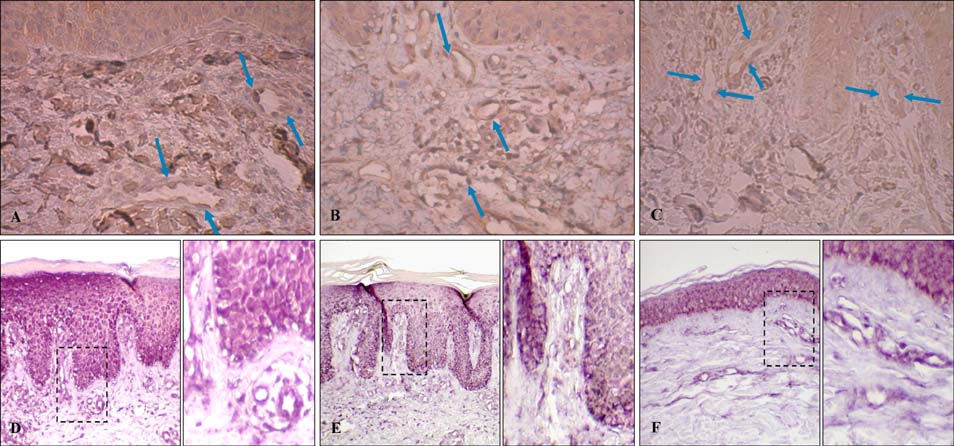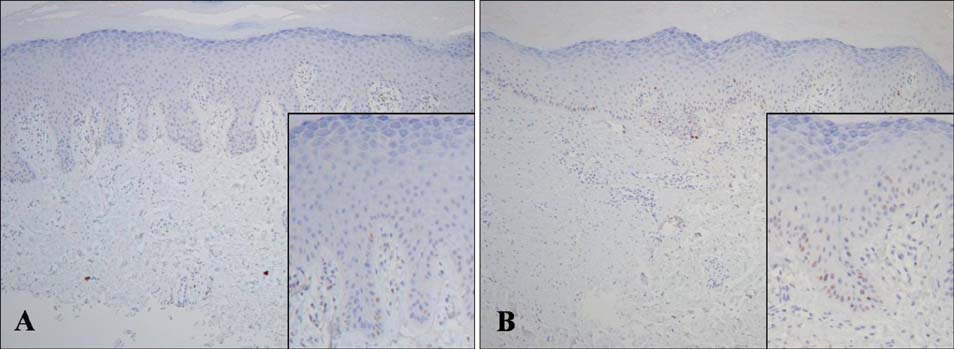Ann Dermatol.
2014 Aug;26(4):517-520. 10.5021/ad.2014.26.4.517.
Tazarotene-Induced Gene 3 May Affect Inflammatory Angiogenesis in Psoriasis by Downregulating Placental Growth Factor Expression
- Affiliations
-
- 1Department of Dermatology, College of Medicine, Dong-A University, Busan, Korea. khkim@ dau.ac.kr
- 2Beautiful Esthetic & Dermatologic Clinics, Busan, Korea.
- 3Department of Dermatology, Sorokdo National Hospital, Goheung, Korea.
- KMID: 2265597
- DOI: http://doi.org/10.5021/ad.2014.26.4.517
Abstract
- No abstract available.
MeSH Terms
Figure
Reference
-
1. Creamer D, Sullivan D, Bicknell R, Barker J. Angiogenesis in psoriasis. Angiogenesis. 2002; 5:231–236.2. Oura H, Bertoncini J, Velasco P, Brown LF, Carmeliet P, Detmar M. A critical role of placental growth factor in the induction of inflammation and edema formation. Blood. 2003; 101:560–567.
Article3. Detmar M, Brown LF, Claffey KP, Yeo KT, Kocher O, Jackman RW, et al. Overexpression of vascular permeability factor/vascular endothelial growth factor and its receptors in psoriasis. J Exp Med. 1994; 180:1141–1146.
Article4. Bhushan M, McLaughlin B, Weiss JB, Griffiths CE. Levels of endothelial cell stimulating angiogenesis factor and vascular endothelial growth factor are elevated in psoriasis. Br J Dermatol. 1999; 141:1054–1060.
Article5. Kuroda K, Sapadin A, Shoji T, Fleischmajer R, Lebwohl M. Altered expression of angiopoietins and Tie2 endothelium receptor in psoriasis. J Invest Dermatol. 2001; 116:713–720.
Article6. Odorisio T, Cianfarani F, Failla CM, Zambruno G. The placenta growth factor in skin angiogenesis. J Dermatol Sci. 2006; 41:11–19.
Article7. Ku BS, Lee CW, Kim KH. Therapeutic effects of tazarotene on psoriasis and its potential action mechanism in inflammatory angiogenesis. Korean J Dermatol. 2007; 45:898–907.8. Eckert RL, Sturniolo MT, Jans R, Kraft CA, Jiang H, Rorke EA. TIG3: a regulator of type I transglutaminase activity in epidermis. Amino Acids. 2009; 36:739–746.
Article9. Ou CC, Hsu SC, Hsieh YH, Tsou WL, Chuang TC, Liu JY, et al. Downregulation of HER2 by RIG1 involves the PI3K/Akt pathway in ovarian cancer cells. Carcinogenesis. 2008; 29:299–306.
Article10. Bottomley MJ, Webb NJ, Watson CJ, Holt L, Bukhari M, Denton J, et al. Placenta growth factor (PlGF) induces vascular endothelial growth factor (VEGF) secretion from mononuclear cells and is co-expressed with VEGF in synovial fluid. Clin Exp Immunol. 2000; 119:182–188.
Article
- Full Text Links
- Actions
-
Cited
- CITED
-
- Close
- Share
- Similar articles
-
- Therapeutic Effects of Tazarotene on Psoriasis and Its Potential Action Mechanism in Inflammatory Angiogenesis
- Insulin-like Growth Factor-II (IGF-II) Induces Vascular Endothelial Growth Factor (VEGF) Expression through IGFR-1 and ERK1/2 Activation in Psoriasis
- Increased expression of the epidermal growth factor receptor gene in psoriasis
- Immunohistochemical Studies of Angiogenic Factors on Psoriatic Lesions
- The Relationship between PTEN Tumor Suppressor Gene and Vascular Endothelial Growth Factor-Mediated Angiogenesis in Breast Cancer



